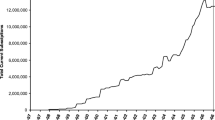Abstract
This paper develops a method to estimate the demand for network goods, using minimal network data, but leveraging within-consumer variation. I estimate demand for video games as a function of individuals’ social networks, prices, and qualities, using data from Steam, the largest video game digital distributor in the world. I separately identify price elasticities on individuals with and without friends with the same game, conditional on individual fixed effects and games’ characteristics. I then use the discrepancies between estimated price elasticities to identify the impact of social networks. I compare my method to “traditional-IV” strategies in the literature, which require detailed network data, and find similar results. A 1% increase in friends’ demands, increases demand by .13%. In counterfactual simulations, I find demand increases by about 5% from a promotional giveaway to “influencers,” those users in the top 1% of popularity in the network.


Similar content being viewed by others
Notes
When an individuals’ demand for a product increases with the number of others’ demand, we have a direct network effect (e.g., communication networks). In contrast, indirect network effects arise on multi-sided markets where the individuals’ demand for a product in one side of the market increases with the supply of such a product from another side of the platform, which in turn increases with individuals’ demand (e.g. online platforms). For instance, if a positive network effect is ignored, the price elasticity of demand will be overestimated, because the total effect of a price change is composed of a price effect and a network effect.
ARD refers to answers to questions of the form “how many of your links have trait X?”
Users can change their privacy settings to minimize the information shared with friends and the general public. However, users are “nudged” into public profiles.
Data and replication files can be found in the author’s website (jtudon.com) or by request. The raw data can be found in https://steam.internet.byu.edu.
In the literature, β might also be known as a peer effect, a network externality, or a consumption spillover between agents. Where appropriate, I also use the term network elasticity of demand to refer to \(\partial \log q/\partial \log n=\upbeta n/q.\)
In the peer-effects literature, the common approach is a group-level analog of Eq. 1, instead of an individual-level model.
In other words, we require repeated observations for individuals, like in this case with multi-product adoptions, in order to address selection concerns. Alternatively, as a referee pointed out, with single-product adoptions, but multiple periods of time per individual, we would require individuals consumption to be always observable to their network.
See Imbens and Angrist (1994), for example.
Always-takers represent less than 2% of the population. Table 1, “Users with friends” shows essentially summary statistics for compliers, and never-takers’ statistics are under “Users without friends”.
To boot, most of the unreported coefficients of the controls also yield estimates of the network effect around 0.9. I do not report these results, because I do not have a strong identification argument for these coefficients.
Nair (2007) reports short-run price elasticities similar to those found in this paper.
Note that from the FOC on β, \(\frac {\partial {s_{ij}}}{\partial {\upbeta }} = F^{\prime } \left (\mu _{i} -\alpha \log p_{j} + \upbeta n_{ij}+ \gamma \log r_{j} + \boldsymbol {\delta }_{0}\boldsymbol {x}_{j} \right ) \upbeta \frac {\partial {s_{ij}}}{\partial {\upbeta }}\), which does not identify β.
References
Angrist, J D (2014). The perils of peer effects. Labour Economics, 30, 98–108.
Banerjee, A, Chandrasekhar, A G, Duflo, E, & Jackson, M O (2013). The diffusion of microfinance. Science, 341, 6144.
Becker, G S (1991). A note on restaurant pricing and other examples of social influences on price. Journal of Political Economy, 99(5), 1109–1116.
Belanche, D, Casaló, L V, Flavián, M, & Ibáñez-Sánchez, S (2021). Understanding influencer marketing: The role of congruence between influencers, products and consumers. Journal of Business Research, 132, 186–195.
Bertrand, M, Luttmer, E F P, & Mullainathan, S (2000). Network effects and welfare cultures. Quarterly Journal of Economics, 115(3), 1019–1055.
Björkegren, D (2019). The adoption of network goods: Evidence from the spread of mobile phones in Rwanda. The Review of Economic Studies, 86(3), 1033–1060.
Breza, E, & Chandrasekhar, A G (2019). Social networks, reputation, and commitment: Evidence from a savings monitors experiment. Econometrica, 87(1), 175–216.
Breza, E, Chandrasekhar, A G, McCormick, T H, & Pan, M. (2020). Using aggregated relational data to feasibly identify network structure without network data. American Economic Review, 1–28.
Chamberlain, G (1980). Analysis of covariance with qualitative data. The Review of Economic Studies, 47(146), 225.
Chandrasekhar, A G, Kinnan, C, & Larreguy, H (2018). Social networks as contract enforcement: Evidence from a lab experiment in the field. American Economic Journal: Applied Economics, 10(4), 43–78.
De Giorgi, G, Frederiksen, A, & Pistaferri, L (2020). Consumption network effects. The Review of Economic Studies, 87(1), 130–163.
Dubé, J-P H, Hitsch, G J, & Chintagunta, P K (2010). Tipping and concentration in markets with indirect network effects. Marketing Science, 29(2), 216–249.
Fortin, B, & Boucher, V (2016). Some challenges in the empirics of the effects of networks. In Y Bramoullé, A Galeotti, & B Rogers (Eds.) The Oxford handbook of the economics of networks (pp. 276–302). Oxford University Press.
Hartmann, W R, Manchanda, P, Nair, H, Bothner, M, Dodds, P, Godes, D, Hosanagar, K, & Tucker, C (2008). Modeling social interactions: Identification, empirical methods and policy implications. Marketing Letters, 19(3–4), 287–304.
Imbens, G W, & Angrist, J D (1994). Identification and estimation of local average treatment effects. Econometrica, 62(2), 467.
Lancaster, T (2000). The incidental parameter problem since 1948. Journal of Econometrics, 95(2), 391–413.
Lee, R S (2013). Vertical integration and exclusivity in two-sided markets. The American Economic Review, 103(7), 2960–3000.
Manski, C F (1993). Identification of endogenous social effects: The reflection problem. The Review of Economic Studies, 60(3), 531.
Martínez-López, F J, Anaya-Sánchez, R, Fernández Giordano, M, & Lopez-Lopez, D (2020). Behind influencer marketing: Key marketing decisions and their effects on followers’ responses. Journal of Marketing Management, 36(7–8), 579–607.
Nair, H (2007). Intertemporal price discrimination with forward-looking consumers: Application to the US market for console video-games. Quantitative Marketing and Economics, 5(3), 239–292.
O’Neill, M, Vaziripour, E, Wu, J, & Zappala, D (2016). Condensing steam: Distilling the diversity of gamer behavior. In Proceedings of the 2016 ACM on internet measurement conference - IMC ’16 (pp. 81–95). New York: ACM Press.
Petrin, A, & Train, K (2010). A control function approach to endogeneity in consumer choice models. Journal of Marketing Research, XLVI, 3–13.
Ryan, S P, & Tucker, C. (2012). Heterogeneity and the dynamics of technology adoption, 10(1).
Rysman, M (2019). The reflection problem in network effect estimation. Journal of Economics and Management Strategy, 28(1), 153–158.
Sacerdote, B (2001). Peer effects with random assignment: Results for Dartmouth roommates. Quarterly Journal of Economics, 116(2), 681–704.
Tucker, C (2008). Identifying formal and informal influence in technology adoption with network externalities. Management Science, 54(12), 2024–2038.
Author information
Authors and Affiliations
Corresponding author
Additional information
Publisher’s note
Springer Nature remains neutral with regard to jurisdictional claims in published maps and institutional affiliations.
Thanks to Michael Dinerstein, Ali Hortaçsu, Mauricio Romero, Adrián Rubli, and ITAM’s applied micro workshop participants. Adrián Martínez provided outstanding research assistance.
Rights and permissions
About this article
Cite this article
Tudón, J. Distilling network effects from Steam. Quant Mark Econ 20, 293–312 (2022). https://doi.org/10.1007/s11129-022-09254-5
Received:
Accepted:
Published:
Issue Date:
DOI: https://doi.org/10.1007/s11129-022-09254-5




